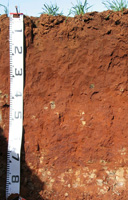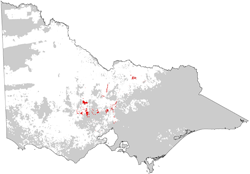Victorian Grain Cropping Soils - Ferrosols
Back to: Soils of Victorian Grain Cropping Regions
| Ferrosols are deep red friable soils that lack strong texture contrast between surface (A) horizons and the upper subsoil (B21) horizon. These soils are characterised by relatively high levels of free iron oxide (i.e. free iron oxide content greater than 5%) and are generally strongly acid in the upper soil profile. |  Example of a Ferrosol |
| Red Ferrosols are not a major grain cropping soil as they are most prevalent in higher rainfall areas and on hilly terrain. In the grain cropping region, they largely occur along the Great Divide in central Victoria, between Ballarat and Castlemaine, on volcanic plains and vents, generally in higher rainfall areas. |  |
Ferrosols have high levels of free iron oxide which gives them a high degree of structural stability. Due to their high iron oxide contents these soils tend to "fix" phosphorus which makes it less available to plants. Regular phosphorus application will assist in overcoming such a deficiency. Zinc and copper can also be 'fixed' by high iron oxide contents.
These soils are usually deep and very well drained due to their strongly developed structure and lack of strong texture contrast between surface and subsoil horizons. Water infiltration rates will be high unless significant compaction has occurred. In some areas they may be stony which makes them less suited to cultivation.
Plant Available Water Capacity (PAWC) is usually high on these soils as there are few restrictions to plant rooting depth and they have high clay content and organic matter levels in the upper profile. Due to their high clay content in surface horizons, however, the high wilting point can be quite high, indicating that plants will not be able to effectively utilise light rains falling on relatively dry soil.
Soil compaction from trafficking, over-stocking or cultivation can lead to reduced water infiltration and retention as well as an increase in soil strength (resulting in mechanical resistance to roots) and cloddiness. These soils are more prone to compaction when the soil is wetter than the plastic limit. Ideally, tillage, trafficking and stocking should occur when the soil is drier than the plastic limit (at least within the top 40 cm from the surface or to the depth of cultivation). Compaction on soils such as these can be more serious on these soils than on cracking clay soils that tend to self-repair due to their strong shrink-swell capacity.
Red Ferrosols have a high pH buffering capacity (i.e. require a larger lime application to raise soil pH). Over-liming, however, may result in some micronutrient deficiencies. As they are often strongly acid (at least in the upper soil profile) the level of exchangeable aluminium can become high which will restrict the growth of aluminium-sensitive species.
BRed Ferrosols generally have high organic matter levels, enhancing soil fertility and aggregate stability. When intensively cropped, organic matter levels will decline and this will result in some structural degradation and fertility decline. Studies have shown that organic matter is an important source of nitrogen, phosphorus and sulphur in such soils. Management practices that result in increased organic matter levels include: minimum tillage; growing green manure crops (e.g. annual ryegrass, sorghum, oats, lupins); incorporating pasture phases in crop rotations, and retaining and incorporating crop residues (Cotching 1995).
Note: For an excellent review paper on management of Ferrosols refer to Cotching (1995).
References
Cotching, B. (1995). Long term management of krasnozems in Australia. Aust. J. Soil and Water Cons. 8:1 (pp 18-27).


